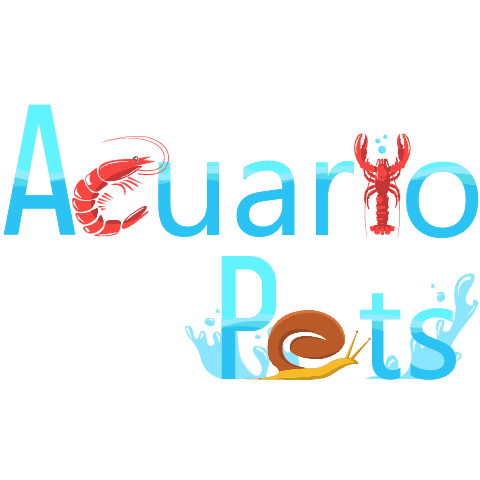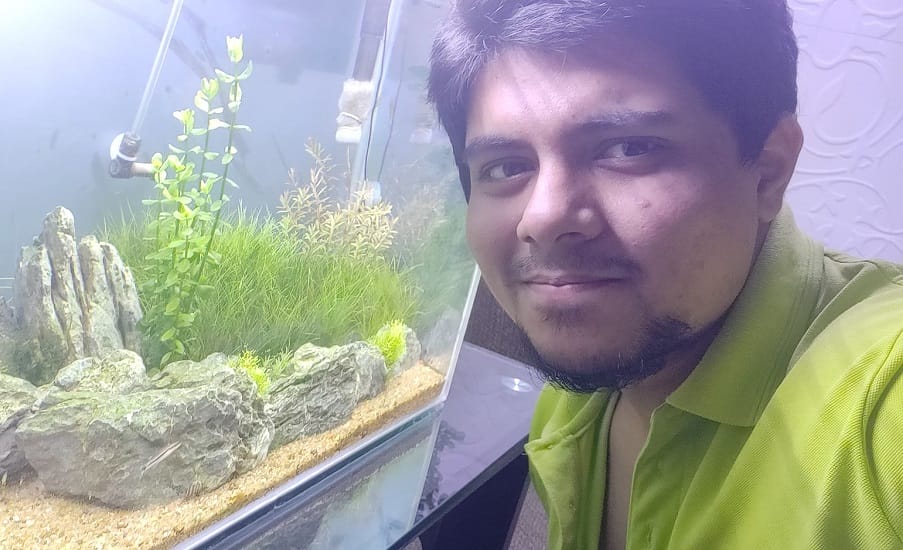This post was created with help from AI tools and carefully reviewed by a human (Muntaseer Rahman) . For more on how we use AI on this site, check out our Editorial Policy.
Check Out These FREE Tools We Made JUST For You!
The No-Stress Betta Tank Setup Guide (Even Beginners Can Nail It)
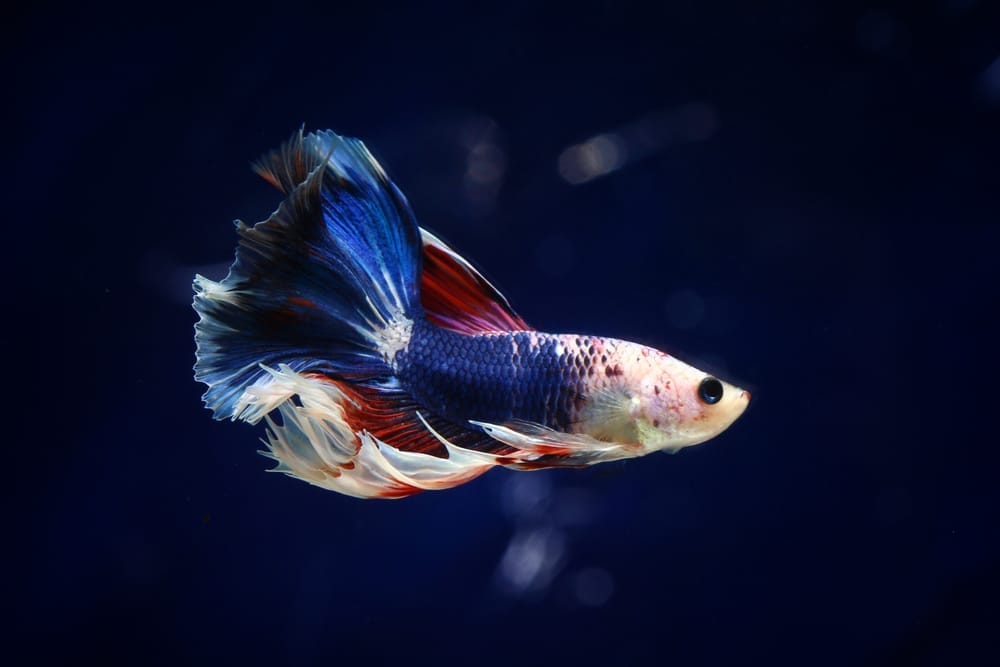
Setting up a betta tank sounds easy until you realize how much bad advice is floating around.
Bowls? Useless. Tiny plastic kits? Might as well be fish traps.
The good news? You can create a proper betta home without losing your mind or blowing your budget. Even if you’ve never owned a fish before.
This guide walks you through everything—what you actually need, what to avoid, and how to get your tank running without turning it into a stress fest (for you or your betta).
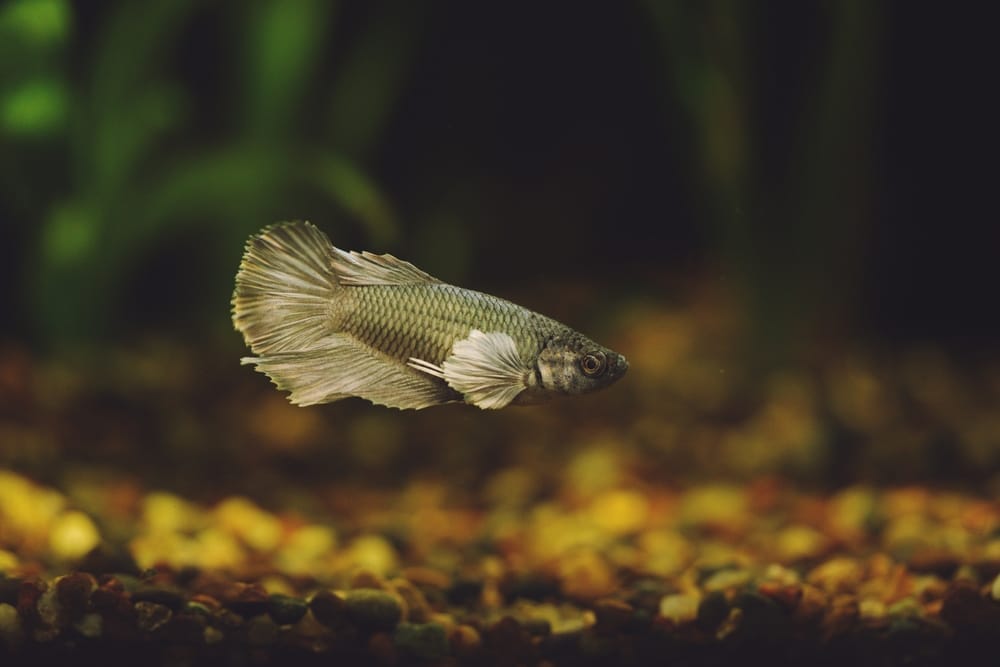
Essentials Checklist (What You Actually Need)
Forget the overpriced starter kits and shiny junk. Here’s what actually matters if you want a happy, healthy betta.
Not sure where to buy all this? We’ve done the research for you. Check out our Complete Betta Fish Owner Essentials guide with specific product recommendations for every item below.
Tank (5 gallons or more)
The bare minimum is 5 gallons. Anything smaller becomes a water quality nightmare. A 10-gallon tank gives you more breathing room and fewer beginner mistakes.
Our top pick: Aqueon 10-Gallon Starter Kit – includes tank, filter, and LED lighting in one package.
Heater
Bettas aren’t goldfish. They need warm, tropical water—around 78 to 80°F. A good adjustable heater is non-negotiable.
What we recommend: See our heater recommendations – we cover both preset and adjustable options.
Filter
They don’t like strong currents, so use a gentle filter or add a sponge to slow the flow. It keeps the water clean without blowing your fish around.
Best options: Check our filter guide for gentle, betta-safe filtration systems.
Thermometer
Yes, you really do need one. Guessing the temperature doesn’t work. Stick it to the tank and check it daily.
Water Conditioner
Tap water isn’t safe by default. Always use a water conditioner to remove chlorine and other harmful stuff.
Our go-to: Seachem Prime – the best water conditioner on the market.
Substrate
Use gravel or sand—just rinse it well first. Go for about 1 to 2.5 inches deep. Darker colors help your betta feel more secure.
Plants and Décor
Live or silk plants work best. Add caves, driftwood, and hideouts, but avoid sharp plastic stuff that can tear fins. More cover means less stress.
Safe options: See our decoration recommendations for betta-safe plants and caves.
Lighting
Moderate light is fine. If it looks like a nightclub, it’s too much. Use soft lighting or let plants help diffuse it.
Test Kit
You’ll need one to check ammonia, nitrite, nitrate, and pH. Especially during the first few weeks, it’s your best defense against invisible problems.
Don’t waste money on strips: Get the API Master Test Kit – it’s more accurate and lasts longer.
Quick Shopping List
Need everything at once? Visit our complete essentials guide for a full shopping list with links to every product.

Step-by-Step No-Stress Setup
1. Clean Everything First
Rinse the tank, gravel or sand, plants, and décor under warm water. No soap. Just scrub with your hands or a clean sponge.
Get rid of any dust, glue, or factory grime.
2. Add Substrate and Décor
Spread your substrate evenly—about 1 to 2.5 inches deep. Place your plants, hideouts, and driftwood. Build a layout that looks natural and gives your betta hiding spots.
Leave space near the surface for breathing and resting.
3. Install Equipment
Place the filter and heater where they fit best. Don’t plug anything in yet. You’ll do that after adding water.
4. Fill the Tank
Pour in tap water slowly so you don’t mess up your layout. Leave about an inch of space from the top. Now add the water conditioner as directed on the bottle.
5. Start the Filter and Heater
Plug in the filter and set it to the lowest flow setting. Turn on the heater and set it to 78–80°F. Stick your thermometer where it’s easy to read.
6. Begin Cycling the Tank
This part is boring but important. You’re growing good bacteria that break down fish waste. Without it, your tank becomes toxic fast.
You’ve got two options:
- Fishless cycle (recommended): Add bottled bacteria and a little ammonia to “feed” the cycle.
- Fish-in cycle (not ideal): If your betta’s already here, use bottled bacteria and test the water daily. Do small water changes often.
The cycle takes 4–6 weeks. It’s done when ammonia and nitrite are both zero and nitrate shows up.
7. Test the Water
Use your test kit to track ammonia, nitrite, and nitrate. Don’t add your fish until the numbers look safe. If you rush this step, your betta pays the price.
Once the tank is cycled, you’re finally ready for your betta.

Acclimate Your Betta (The Gentle Way)
Don’t just dump your betta into the tank. That’s a great way to shock it. Here’s how to do it right, without causing stress or fin damage.
1. Float the Cup or Bag
Place the sealed cup or bag your betta came in right into the tank. Let it float on the surface for 15 to 20 minutes. This lets the temperature slowly equalize.
2. Add Tank Water Gradually
After the float, open the cup or bag and add a small bit of tank water to it. Just a few tablespoons.
Pro tip: Use a clean cup from your kitchen or a small container. If you need a dedicated aquarium net for future maintenance, check our essential accessories.
Wait 5 minutes. Then add a bit more.
Repeat this 3–4 times over the next 20–30 minutes. You’re helping your betta adjust to new water chemistry without freaking it out.
3. Use a Net to Transfer
Once you’re done, gently net the betta and move it into the tank. Don’t pour store water into the tank—it can carry stuff you don’t want.
Let your betta swim out on its own if possible.
After that, lights off. Give it peace and quiet for the rest of the day. No tapping, no food, no staring contests.

First Few Days After Setup
Now that your betta’s in, here’s what not to do: don’t hover, don’t overfeed, and don’t panic if it hides.
Keep the Lights Low
Leave the lights off or dim for the first 24–48 hours. Moving is stressful, and bright light makes it worse.
Feed Lightly
Stick to a small amount—2 to 5 high-quality pellets once or twice a day. We recommend Hikari Betta Bio-Gold for optimal nutrition.
Don’t Rearrange the Tank
Avoid moving plants or décor for now. Your betta’s figuring out the layout and needs stability, not another surprise.
Let It Be
No tapping, no chasing, no hands in the water. Watch from a distance. The less you bug it, the faster it settles.
Monitor Temperature and Water
Make sure the heater’s holding steady at 78–80°F. If you’re cycling with the fish in, test daily and do small water changes when needed.
Add More Cover If Needed
If your betta looks nervous—hiding a lot, darting, or clamping its fins—add more plants or soft décor. Dense cover helps them feel safe.
Give it a few calm days and you’ll start seeing natural behavior—exploring, flaring, maybe even bubble nests.
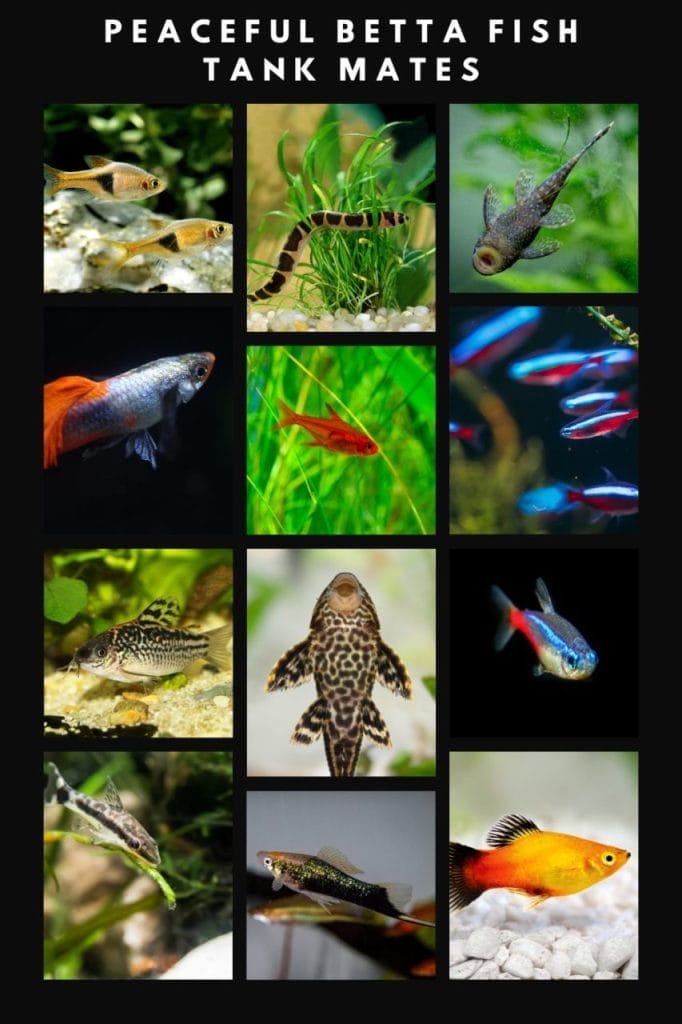
Beginner-Friendly Tank Design Tips
You don’t need a degree in aquascaping to make your betta feel at home. Just keep it simple, soft, and safe.
Go for Live or Silk Plants
Live plants are the best—they clean the water, break up light, and make the tank look alive. Easy options: Java fern, Anubias, Amazon sword, Cryptocoryne, and floating plants like frogbit.
Need help choosing safe decorations and plants? Our decoration guide covers everything from live plants to betta hammocks.
Silk plants are fine too. Just avoid plastic ones—they tear fins faster than you think.
Add Hiding Spots
Caves, driftwood, betta logs, and leafy cover all work. Bettas want places to retreat and chill. The more cozy spots, the better.
Use a Betta Hammock
These little leaf-shaped pads stick near the surface. Bettas love to rest close to the top where they can breathe easily.
Soften the Filter Flow
Too much current will wear your fish out. Use a sponge filter or cover your filter output with foam. Still water with gentle movement is the goal.
Keep the Layout Open but Secure
Don’t pack every inch of the tank, but don’t leave it empty either. Aim for an open swimming area in front, with plants and cover in the back and sides.
Pick a Dark Background
A dark tank background reduces reflections and helps shy bettas feel less exposed. Black poster board taped to the back works just fine.
If your setup looks natural and your betta isn’t hiding all the time, you’re doing it right.
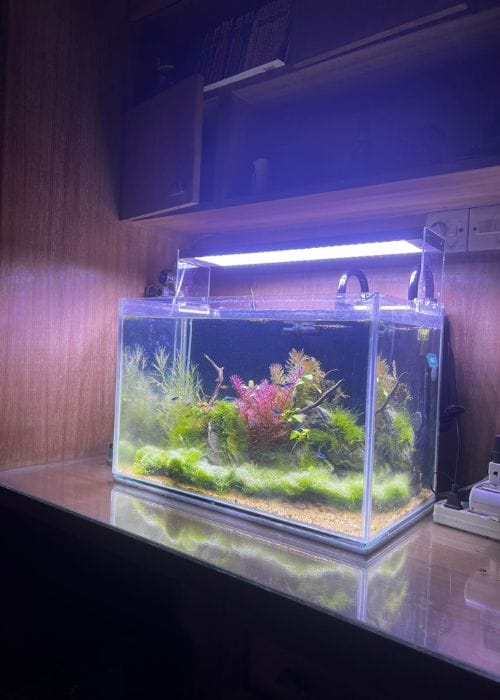
Optional but Helpful Add-Ons
You don’t need these to keep your betta alive, but they’ll make maintenance easier and your betta happier. For specific product recommendations on all of these, check our complete equipment guide.
You don’t need these, but they’ll make your life easier and your betta’s life better.
Tank Lid or Cover
Bettas jump. A lid keeps them in the tank and helps maintain stable temps and humidity.
Light Timer
Set it and forget it. A timer keeps the day-night cycle consistent without you having to remember.
Background
A plain black or dark blue background helps reduce reflections and makes your betta feel more secure. Bonus—it also hides cords.
Floating Leaf or Betta Bed
Bettas love lounging near the surface. A floating leaf or suction-cup “bed” gives them a comfy spot to rest.
Aquarium Tongs or Tweezers
Useful for placing plants or grabbing gunk without getting your hands wet. Makes tank maintenance a bit less annoying.
Glass Scraper or Algae Magnet
Keeps the tank walls clean without draining your patience. Skip the gimmicks—get a simple one that works.
These little upgrades aren’t essential, but once you have them, you’ll wonder why you waited.

Quick Tips to Minimize Betta Stress
These small things make a big difference—don’t skip them.
Keep the Temperature Steady
No sudden swings. Use a good heater and check the thermometer daily.
Avoid Loud Noises Near the Tank
Slamming doors, blasting music, or placing the tank next to speakers—bad idea. Bettas feel vibrations.
Don’t Tap the Glass
It doesn’t “wake them up.” It just stresses them out.
Do Small Water Changes, Not Huge Ones
Stick to 20% or less at a time. Changing too much can mess with water chemistry and shock your betta.
Don’t Chase or Scoop for Fun
Only use a net when absolutely needed—like during a deep clean or emergency.
Add Cover If Your Betta Seems Nervous
If it’s hiding constantly or has clamped fins, add more plants or décor. Safe places = calmer fish.
Give It Time
Some bettas settle in fast. Others take days. Let it adjust at its own pace without over-interacting.
Stress is sneaky. Keep things calm and steady, and your betta will bounce back like a champ.

Can Bettas Have Tank Mates?
Yes, but it’s not as simple as tossing in a few fish and hoping for the best.
Bettas are territorial. Some are chill, others act like tiny water dragons. So before adding anything, ask yourself two things:
- Is your tank at least 10 gallons? (Seriously, don’t try tank mates in anything smaller)
- Are you ready to separate them if things go sideways?
Safer Tank Mate Options
These have a better chance of working—but always watch closely:
- Snails – Nerite or mystery snails mind their own business and clean up a bit.
- Shrimp – Amano or ghost shrimp might be okay, but some bettas see them as snacks.
- Peaceful bottom dwellers – Like kuhli loaches, but only in larger tanks with hiding spots.
What to Avoid
- Other bettas (especially males)
- Flashy fish like guppies
- Fin nippers like tiger barbs
- Anything that outcompetes your betta for food
The Safer Bet? Go Solo
Bettas do just fine alone. If this is your first tank, keep it simple. Once you’ve got more experience (and a bigger tank), you can experiment.
Tank mates are possible—but never guaranteed. It depends on your setup and your betta’s personality. Always have a backup plan.

Common Beginner Mistakes to Avoid
If you’re new to bettas, don’t worry. Most of these mistakes are easy to avoid once you know what to watch for.
Buying a Tiny Bowl
It’s not a home—it’s a prison. Small containers get dirty fast and stress the fish out. Go for 5 gallons or more—we recommend the 10-gallon Aqueon kit as the sweet spot for beginners.
Skipping the Cycle
No cycle = toxic water. Don’t add your betta before the tank is ready. That ammonia spike? It can kill.
Using Plastic Plants
They might look cool, but they shred fins. Stick with silk or live plants only.
Cranking the Filter
Too much current will exhaust your betta. Use a sponge filter or baffle the output.
Overfeeding
They’ll beg. You’ll cave. But too much food leads to bloating and filthy water. Keep it small and regular.
Changing Too Much Water at Once
Large water swaps can shock your betta. Stick to small, steady changes—around 20% a week.
Adding Tank Mates Too Soon
Not all bettas play nice. Adding other fish before your tank is stable or before you understand your betta’s behavior is a recipe for stress.
Treating Them Like Decorations
Bettas are living creatures, not centerpieces. Give them clean water, safe space, and time to adjust.
If you avoid these, you’re already ahead of half the internet advice out there.
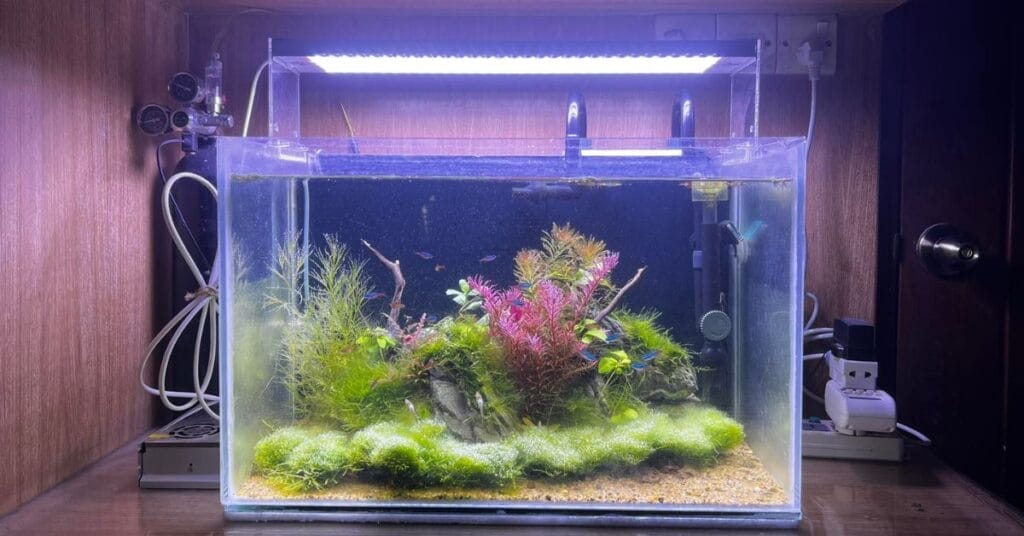
Your Complete Betta Setup Shopping List
Ready to buy everything? Here’s your exact checklist with links to our recommended products:
Essential Equipment (Can’t Skip These)
- [ ] 10-Gallon Tank Kit – Aqueon or Fluval
- [ ] Adjustable Heater (50W) – Aqueon or Eheim
- [ ] Gentle Filter – Sponge filter or adjustable HOB
- [ ] Thermometer (floating or stick-on)
- [ ] Water Conditioner – Seachem Prime
- [ ] Test Kit – API Master Test Kit
- [ ] Quality Betta Food – Hikari Betta Bio-Gold
Décor & Substrate
- [ ] Gravel or sand substrate (1-2 inches deep)
- [ ] Live or silk plants – Java Fern, Anubias
- [ ] Betta cave or hideout
- [ ] Driftwood (optional but recommended)
Helpful Add-Ons
- [ ] Tank lid or cover
- [ ] Light timer
- [ ] Betta hammock
- [ ] Gravel vacuum
- [ ] Net
Estimated Total Cost: $100-150 for a complete, proper setup
Save time: Get all our recommendations in one place →
Betta Tank Setup FAQs (Read This Before You Panic)
What’s the smallest tank I can use for a betta?
Stick to at least 5 gallons. A bigger tank (like 10 gallons) makes life easier and keeps your betta healthier. We specifically recommend the Aqueon 10-Gallon Starter Kit.
Do bettas really need a heater and filter?
Yes to both. They need warm water (78–80°F) with a reliable heater, and a gentle filter helps keep things clean without stressing them out.
How do I “cycle” my tank before adding the fish?
Cycling builds up helpful bacteria that break down fish waste. You can cycle the tank using bottled bacteria and testing water for ammonia, nitrite, and nitrate. It usually takes 4–6 weeks.
Can I use regular tap water?
Yes, but you must use a water conditioner to remove harmful chemicals like chlorine and chloramine. We recommend Seachem Prime.
What decorations and substrate are safe?
Use soft-edged décor and silk or live plants. Avoid sharp plastic stuff that can rip fins. Gravel or sand is fine—just rinse it well first.
How often should I change the water?
Do small water changes (around 20%) once a week. Don’t clean everything at once or your tank will crash.
Is it okay to leave the tank open without a lid?
Nope. Bettas are jumpers. Use a lid or mesh cover to stop them from going airborne.
Are pet store betta kits any good?
Most aren’t. They’re often too small and come with bad filters or lights. It’s usually better to buy things separately.
Why is my betta hiding or not moving much?
Could be stress, poor water, or not enough hiding spots. Test your water, check the temperature, and add more plants or caves.
Can I keep other fish with my betta?
Only in a larger tank (10+ gallons) and only if your betta isn’t aggressive. Stick to peaceful tank mates like snails or shrimp, and always watch closely for problems.
How do I test the water?
Use a liquid test kit (not strips). Test for ammonia, nitrite, nitrate, and pH, especially when cycling or if your fish seems sick.
What should I feed my betta?
High-quality betta pellets are best—we recommend Hikari Betta Bio-Gold. Feed 2–5 pellets once or twice a day. Don’t overdo it—they’re tiny fish with tiny stomachs.
Ready to Set Up Your Betta Tank the Right Way?
You now have everything you need to create a proper home for your betta. No more guessing, no more conflicting advice—just follow this guide and you’ll be set.
Your next step: Get the right equipment.
Shop Our Complete Betta Fish Owner Essentials Guide
We’ve tested and vetted every product recommendation. From tanks to food to decorations—everything your betta needs to thrive.
What’s included:
- Specific product recommendations (not just generic advice)
- Links to buy everything in one shopping trip
- Budget and premium options for every category
- Safety tips and what to avoid
Stop wasting money on junk that doesn’t work. Get it right the first time.
About Author
Hello, I’m Muntaseer Rahman, the owner of AcuarioPets.com. I’m passionate about aquarium pets like shrimps, snails, crabs, and crayfish. I’ve created this website to share my expertise and help you provide better care for these amazing pets.
Disclaimer
This site is owned and operated by Muntaseer Rahman. AcuarioPets.com is a participant in the Amazon Services LLC Associates Program, an affiliate advertising program designed to provide a means for sites to earn advertising fees by advertising and linking to Amazon.com. This site also participates in other affiliate programs and is compensated for referring traffic and business to these companies.
